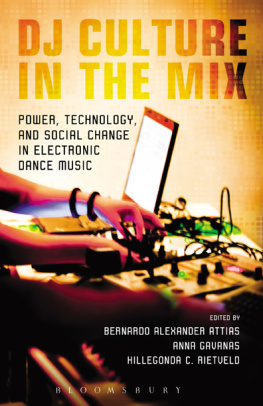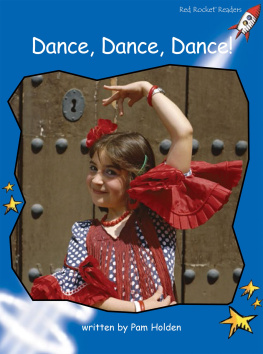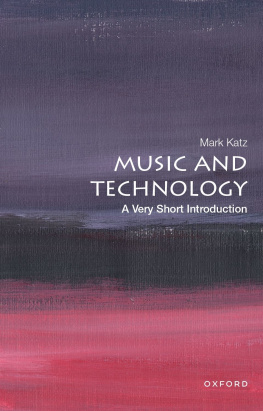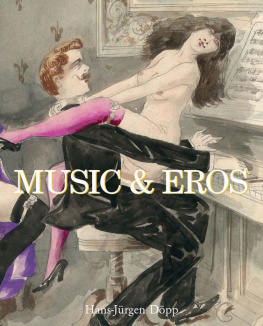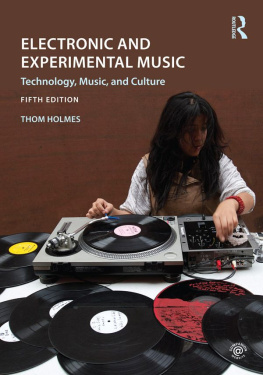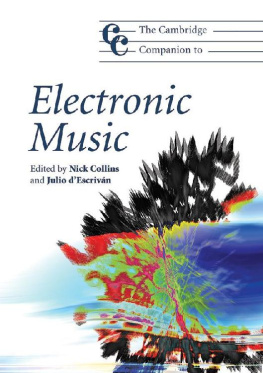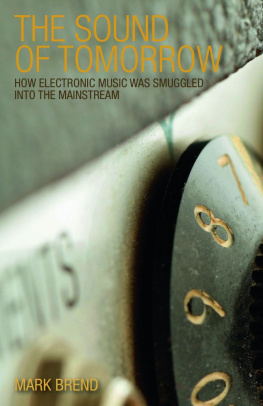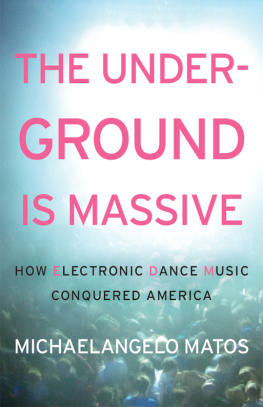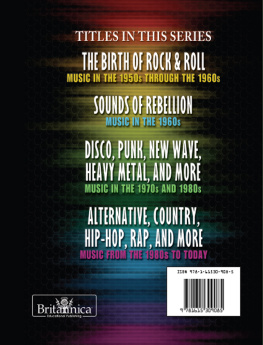DJ Culture in the Mix
DJ Culture in the Mix
Power, Technology, and Social Change in Electronic Dance Music
EDITED BY
BERNARDO ALEXANDER ATTIAS
ANNA GAVANAS
HILLEGONDA C. RIETVELD

Bloomsbury Academic
An imprint of Bloomsbury Publishing Inc.
1385 Broadway | 50 Bedford Square |
New York | London |
NY 10018 | WC1B 3DP |
USA | UK |
www.bloomsbury.com
Bloomsbury is a registered trade mark of Bloomsbury Publishing Plc
First published 2013
Bernardo Alexander Attias, Anna Gavanas, Hillegonda C. Rietveld and contributors, 2013
Cover photography by Henrik Landn
All rights reserved. No part of this publication may be reproduced or transmitted in any form or by any means, electronic or mechanical, including photocopying, recording, or any information storage or retrieval system, without prior permission in writing from the publishers.
No responsibility for loss caused to any individual or organization acting on or refraining from action as a result of the material in this publication can be accepted by Bloomsbury or the author.
Library of Congress Cataloging-in-Publication Data
DJ culture in the mix : power, technology, and social change in electronic dance music / edited by Bernardo Alexander Attias, Anna Gavanas, and Hillegonda C. Rietveld.
pages cm
Includes bibliographical references and index.
ISBN 978-1-62356-690-6 (hardcover : alk. paper) -- ISBN 978-1-62356-006-5 (pbk. : alk. paper) 1. Underground dance music--Social aspects. I. Attias, Bernardo Alexander. II. Gavanas, Anna, 1971- III. Rietveld, Hillegonda C.
ML3918.U53D5 2013
781.648--dc23
ISBN: ePub: 978-1-62356-994-5
Typeset by Fakenham Prepress Solutions, Fakenham, Norfolk NR21 8NN
To Graham, international man of mystery.
CONTENTS
Hillegonda C. Rietveld
Bernardo Alexander Attias
Anna Gavanas and Rosa Reitsamer
Hillegonda C. Rietveld
Mirko M. Hall and Naida Zukic
Kai Fikentscher
Jonathan Yu
Ed Montano
Chris Christodoulou
Tim Lawrence
Ivan Paolo de Paris Fontanari
Johanna Paulsson
Simon A. Morrison
The editors thank each other for being great colleagues, working together across time zones in an ever-accelerating pace. We are thankful to each of the authors for their dedication in contributing to a multi-facetted book on the cultures of the electronic dance music DJ, patiently putting up with our endless questions. We thank editors David Barker, Kaitlin Fontana and Ally Jane Grossan at Bloomsbury Publishing for their support of this project. And we are grateful to Graham St John for his unswerving dedication to developing and maintaining the Dancecult network, bringing us together for an electronic dance music culture panel at the Cultural Crossroads conference of the Association of Cultural Studies at West Indies University, Jamaica, back in 2008.
Hillegonda C. Rietveld additionally wishes to acknowledge the Centre for Media and Culture Research at London South Bank University for financially supporting the research time and conference travel related to completing this project. I also thank my students in Music and Sonic Media and my PG research students for their stimulating questions and insights you keep me young! Im especially grateful to Chris Christodoulou, Barbara Panuzzi and Dan Fenton for stimulating conversations regarding music, technology, mediation and the senses. On a personal note, I would not be here without the musicality of my family or Maxs love of food. Finally, I want to thank Will Straw, Sheila Whiteley, Graham St John, Steve Redhead, Martha Tupinamb de Ulha, Sean Albiez, Tim Lawrence, Lisa Blackman, Jeffrey Weeks, Janet Holland and Michal Lyons for their warm academic encouragement. Rest in peace, Michal.
Anna Gavanas sends her biggest respect to her DJ grandmasters and crew. Bigups to Mutamassik, Anaya, Aimnbreak, Paizan, Funky Tuna, Mikronesien, Hardware, Struck, D. Wattsriot and Aroma: relentless instigators, troublemakers on the musical frontline. And bigups to Graham St John, DJ Professor Ben, DJ Empress Gonnie, Hillevi Ganetz, Ann Werner, Hasse Huss, Marie Selander and Johan Forns: musical troopers on the textual frontline. Massive praise also for DJ-horan for decades of carrying record bags and fetching drinks. Plus Sideshow Rodge, of the Meerkat Recordings crew, for messing with my equipment while playing, getting everyone wasted and making sure we get kicked out every once in a while. And huge respect to my musical influencers: Nuphlo, Mala, Kutterfugel, Uzul, Hab, Ombudsman, Jah Warrior and Warrior Queen to name a few. Finally, Gavanas would like to send her thanks to her musical influences beyond life, to her grandfather Kurt Pettersson and her brother Christos Gavanas. And to Henrik Landn, keeping the legacy of Christos alive in sound and vision.
Bernardo Alexander Attias would like to acknowledge his family, colleagues and friends who have put up with his insane work hours and mood swings as this project slowly came together. Special thanks to Dean Robert Bucker and Provost Harry Hellenbrand at California State University Northridge for supporting a sabbatical that allowed me to focus on research for a semester, as well as to University colleagues and staff (particularly Don Brownlee, Daisy Lemus, Rebecca Litke and Yolanda Avila) who helped keep the Department functioning during my absence. Thanks to Henry Krips and Judy Battaglia for inviting me to present some of my early thoughts on DJ culture to their students at Claremont Graduate College and Loyola Marymount University, and to supportive collaborators Christy Brand, Fred Church, Anna Gavanas, Trademark Gunderson, Hillegonda Rietveld, Shane Martin, Randy Stearns and tobias van Veen for participating with me in public performances and think-pieces touching on the questions raised in this collection. Big love to Mieka du Franx, Karina Junker, Elizabeth A. Moore and Beatrice Neumann for sharing their passion for electronic music and constantly introducing me to fresh sounds, and to Jessica Baty-McMillan, Karyl Kicenski, Geoff Klinger, Lilah Martin, Jeanine Ming, Gordon Mitchell and Randi Picarelli for always being fantastic and supportive sounding boards and very dear friends. Max respect to the Scratch DJ Academy family in Los Angeles for their tireless promotion of DJ culture and skills, and for the welcoming sense of community I found among them. Big shout out to the Train Wreck Crew and the teachers and students from whom I learned so much, including Denkym, Hapa, Shortee, Faust, Dynamix, Puffs, QUIX05, Lost, Just MATTER, Fade, O, James Jordan, Tosh Biko, and, of course, DJ Hideo. Rest in peace, Hideo. Live life!
Hillegonda C. Rietveld
The electronic dance music DJ: party leader, sonic entertainer, auditory artist, music programmer, record mixer, beatmatcher, cultural masher, music producer, creative music archivist, record collector, sex symbol, role model, upwardly mobile brand, youth marketing tool, dancefloor parent, witch-doctor, tantric yogi, cyborgian shaman, the embodiment of studio-generated music. Mixing music recordings into a long danceable sound track, we find them at work at discos, clubs, rave parties and dance festivals; in smoky dark basements, custom-made dance spaces, squatted warehouses, damp railway arches and lofty penthouse parties; filling stadiums, seducing the beach crowds, playing the crowd. At their best, dance DJs save our nights with their music, push our dancing bodies to the limits of endurance, lull us gently to a restorative state and make us feel reborn. In short, the DJ is endowed with a hefty dose of aura, authenticity and cultural capital; and so are the tools of their trade, not least the residual disco dance single of 12-inch vinyl analogue format. Admittedly, there are plenty of dance DJs offering banal sets of inoffensive dance MP3s, at worst driving their audiences to alcoholism with dull tunes on a distorted soundsystem, as bar-owners count their drink profits. But what do we really know about the dance DJ and the cultural discourses that surround them? Can we explode the myth of the masculine, and increasingly whitewashed, millionaire DJ? How do dance DJs perceive their role, their music, their technologies and their career prospects? What does the DJ do, to make our secret fleeting moments on the dancefloor so special?
Next page
